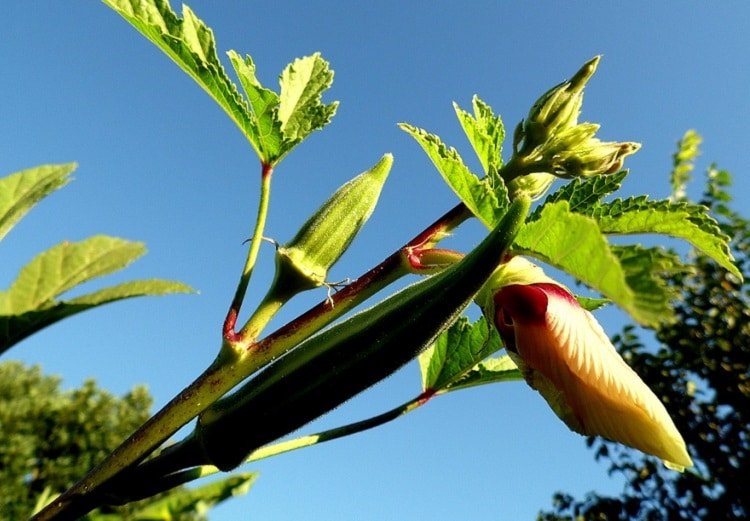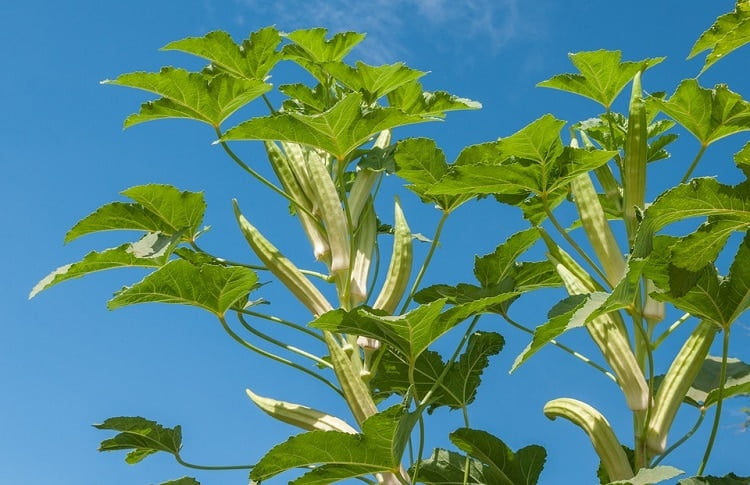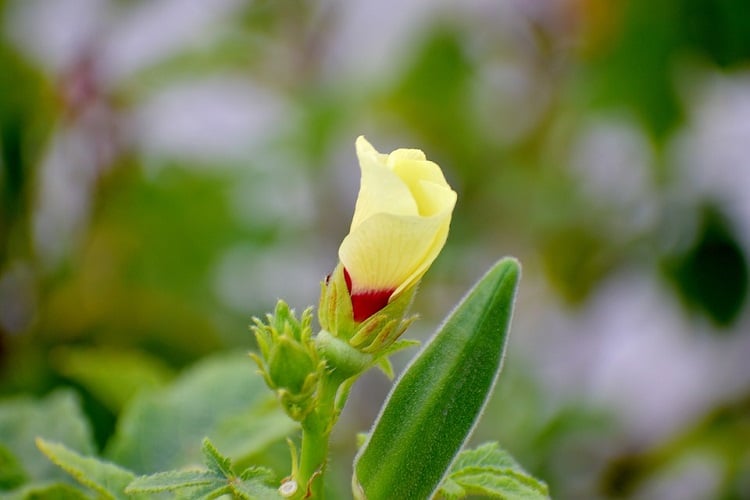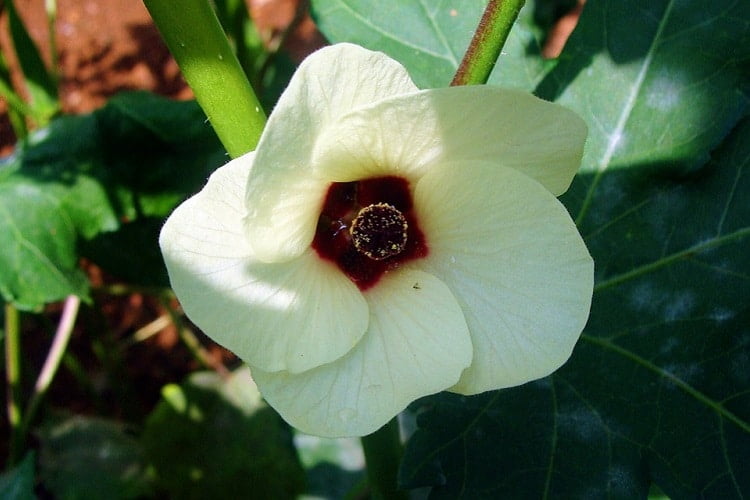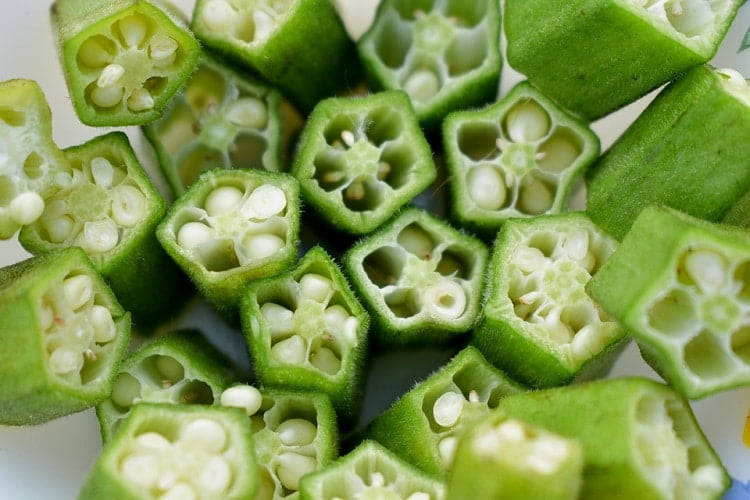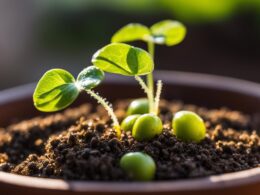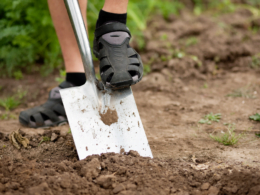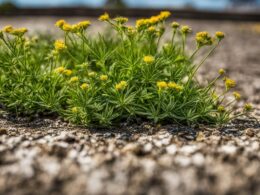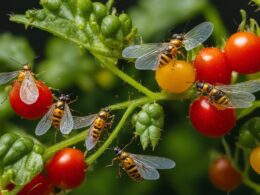Okra is well-known for its culinary properties, as its fruits are often prepared as a side dish among stews and other delicious meals. However, people often grow the plant for its aesthetic properties. Okra’s flowers grow big and beautiful, and those plant varieties with colorful leaves have a great visual impact on your garden. Learn how to grow okra and spice up your backyard.
The background of the okra plant
Okra, by its scientific name Abelmoschus esculentus, is a tall flowering plant that is related to hibiscus, and comes from the hot lands of Africa. Therefore, it’s not native to the United States, and it came here around 1600s. Since it came from a tropical area, it first grew in the South. Now, it got adapted to the climate and can grow in any conditions that also allow corn to grow.
Okra makes appealing flowers, and some varieties can even have colorful leaves and stems. As a result, many people learn how to grow okra for its looks, not necessarily for its nutritious properties. If you want a pretty garden, this plant is a great choice, and it’s not even that hard to grow.
How to grow okra
If you have decided you want this versatile plant in your garden, you should take care of all the details that are related to planting. Before doing the operation, make sure you know where okra thrives, so that your plant will survive. See if the soil is suitable, choose the ideal planting spot, and learn how to take care of it.
Choosing the soil
Any plant needs a certain type of soil to thrive. Some of them can grow mostly anywhere, while others need certain conditions if you want them to grow. In the case of okra, any fertile soil will do. You can either perform crop rotation and plant it in a soil full of nitrogen, where peas grew previously, for instance. Or, you can add some fertilizer in the soil and boost it a bit.
Also, make sure the soil drains well. A musty ground that retains water cannot help any plant thrive, as soaking the roots is bad for mostly everything.
Choosing the timing
Depending on the region where you live, you can have more options. In an area with a warmer climate, you can plant the seeds directly in your garden. Do it at the beginning of spring, after the last frost, when night temperatures are well above the freezing point. However, this doesn’t happen everywhere, and it might be too late to plant the seeds directly outdoors when it’s nearly summer.
In this case, you can start the seeds indoors. Do it about three weeks before the last frost date, and you can transplant them in the garden once the soil is workable. While you’re growing them inside, water the pots regularly. Keep them in a warm and sunny room, as they need some help during germination. If you don’t have enough light, you can use special lamps to keep them warm.
Choosing the place
Before doing the planting, there’s one last thing you should consider. Okra grows better if planted in certain areas in the garden, where it gets all the resources it needs. As you have probably figured out, the plant enjoys sunlight, so it grows well in a spot where it should get full sun for at least six hours every day. It can cope well with the hotness of summer, and only excessive shade is the one you should worry about.
Sow the seeds
At this point, you are ready to prepare the holes that will hold the seeds. Dig them to be about one inch deep, and leave between 12 and 18 inches between them. Arrange them in rows, and leave 4 feet between them. As the plants will grow tall, they need all the space they can get. Before doing the sowing, you can keep the seeds soaking in water the night before. This way, you help them start the germination process a lot more quickly.
How to care for the okra plant
After the planting, you need to take care of the okra and help it grow tall. By keeping it watered, fertilized, and protected from pests and diseases, the plant will reward you with its beautiful blooms and its tasty fruits.
Watering
Okra loves abundant water, so make sure you water it thoroughly every morning until the soil gets moist. The only moment when you can skip the watering is after raining, but it usually thrives when it gets hydrated. A small drought won’t kill the plant, but it will grow bigger and sturdier when it gets plenty of water.
However, be careful when you do the watering. The ideal moment for this treatment is in the morning. This way, the soil will absorb everything before the night comes. Letting the roots soak in water during night can be bad, as they will start rotting. Also, avoid pouring water on leaves, as it will attract the sunlight and they will start burning.
Thinning
Wait until the okras reach about 3 inches in height, and remove the small seedlings from the rows you have just planted. This way, you’ll leave only the strongest ones to grow tall and spread in the garden. This operation is commonly known as thinning
Keeping the weeds away
One important step in learning how to grow okra is learning how to keep it weed-free. Therefore, pay attention to this aspect while the plant is still young. Once you spot any invasive plants around it, remove them without disturbing the okra and the plantations nearby. To prevent more weeds from taking over, you can surround the tiny sprouts with mulch. Pine straw is one of the best options that should keep the ugly plants away.
Fertilizing and composting
Learning how to grow okra will teach you the plant is not that complicated to breed. However, it still needs some nutrients that will speed up its growth, and help it remain sturdy. There are some moments when it’s ideal to add some compost alongside the plants.
First, do it immediately after performing the thinning operation. Then, you can repeat it as you notice the small plants have started growing. The last time to do it is as you reach the half of the growing season. Don’t repeat it more than three times, as you risk suffocating the plants. You can sprinkle some fertilizer here and there but, also, make sure you don’t overdo it.
Protect the okra from pests
Another big threat for okras is represented by the unpleasant pests that constantly attack it. There are plenty of insects that enjoy eating the okra leaves and stems, including the widespread aphids, earworms, or stinkbugs. One solution against them would be to remove the insects by hand, but you can keep them away with soapy water constantly sprayed on plants.
Okras are pretty sturdy, and they can resist mostly anything. However, you can keep the harvest abundant if you remove the unpleasant crops. If you cannot see the insects roaming around on the plants, look out for yellowing stains on the leaves and stems, holes in the body of the plants, or any other unhealthy sign. This way, you’ll know your plants need a treatment.
What to do with the okra plant
You can learn how to grow okra for its beautiful flowers, that will create a dramatic effect in your garden. The okra flower is big and white, with beautifully shaped petals. They create an intricate circular pattern, and are perfect to contrast with other blooms in striking colors. Some okra varieties, like Burgundy, has colorful leaves and stems, so they complete the dramatic effect.
However, okra is a vegetable. It produces fruits every season that you can harvest and eat. Once the pretty blooms fade away, you can wait for the fruit pods to form, and then get ready for the harvest.
How to harvest the okra pods
The fruits pods will appear about eight weeks after planting. By using a scissors, you can make a cut between the stem of the pod and the stem of the plant. The good news is a new pod will replace the one you had cut until the season is over. You can do it every day, until you gather enough fruits for cooking or pickling.
These fruits are tasty while they are fresh. Therefore, soon after harvesting, don’t hesitate to cook them. If the harvest is too numerous to make okra dishes every day, you can pickle the fruits just like you do with cucumbers. Another solution is to place the remaining fruits in the freezer. Do not freeze them fresh, as they won’t last. First, boil the fruits for a few minutes, then cut them into pieces and place them in the freezer.
Summing up
If you want to place your garden somewhere between aesthetics and utility, you should learn how to grow okra. The plant has hypnotizing blooms that make a great décor for your backyard. Once the flowers fade away, you can harvest its delicious fruits either to cook fresh or to preserve for later. Okra is easy to grow, doesn’t require excessive effort, and can even resist to harsher conditions.
Image sources: Pixabay





